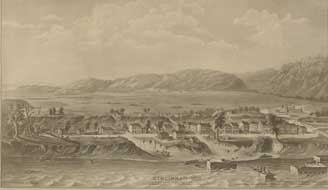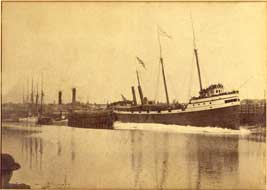THE TRANSPORTATION HISTORY COLLECTION
The Transportation History Collection, formerly part of the Engineering
Library’s Transportation Library, was founded by Professor
John S. Worley in 1923. Worley was the University of Michigan’s
first Professor of Transportation and Railroad Engineering and had
been actively engaged in the design and construction of public works
and railways, while also serving as a valuation engineer for the
Interstate Commerce Commission. His background, combined with an
avid interest in historical materials and a network of connections
in the field, led him to amass almost 60,000 items related to the
history of transportation by 1929. Without a doubt, the history
of railroads—in the United States and overseas—dominates
the holdings, but the collection is also strong in the areas of
road and waterway travel. These materials formed the rich core of
the collection, which in the early 1990s was transferred to the
curatorial jurisdiction of the Special Collections Library for preservation
and further development. Because of its Midwestern location and
Professor Worley’s local affiliations, the Transportation History
Collection contains a substantial amount of material about the development
of transportation in the state of Ohio.
Cincinnati, 1800. Cincinnati, Ohio: Strobridge Lithographing
Co., [n.d.]. Lithographic print.

The
Special Collections Library owns a substantial number of prints,
photographs, and original artwork. These visual materials complement
the printed material in most subject areas. The Transportation History
Collection contains over 12,000 such items, including this early
print of Cincinnati. Cincinnati, in addition to being “The
Queen City of the West,” was a major printing and publishing
center from the earliest days of the Old Northwest Territory.
This view of the city was printed by Strobridge Lithographing Company,
which, along with Gibson Greetings, the Hennegan Company, S. Rosenthal,
and U.S. Playing Card, was founded by master lithographers who had
immigrated to this country in the early nineteenth century. The
print is based on an original painting by an artist named A.J. Swing
and combines an imagined aerial view with map-like components. Thus,
the viewer is able to see the entire town of Cincinnati, including
its waterfront, with each building neatly numbered and identified
in the key at the bottom. The streets are also clearly identified.
Number 14 is Fort Washington, built in 1789–1790 to protect
early settlers, and probably the earliest structure in what shortly
became known as the town of Cincinnati. The building boom to come
is evidenced by the large “Artificer’s Yard” (number
2), as well as the structure in the process of being erected on
Walnut Street. Since the well-known Strobridge Company was not established
until the 1840s, this print dates some decades later than the probable
date of circa 1800 for the original painting.
The “Spokane” Launching, Cleveland, Ohio, 1886. Albumen
print.
 Amongst
the thousands of photographs in the Special Collections Library,
there are a significant number of very early and very rare images.
A print of “Driving the Last (or Golden) Spike,” which
commemorates the completion of the transcontinental railroad in
1869, and a very early daguerreotype in its original case can be
found at the library, and there are also stunning images of ships
and waterways. Shown here is an albumen print of the steamship “Spokane”
being launched in Cleveland. With the completion of the Ohio and
Erie Canals in 1832, Cleveland eventually became the most important
general cargo port on Lake Erie, with an active shipbuilding industry
to support it. The “Spokane,” completed by the Globe Iron
Works Company in 1886, was the first steel-hulled vessel to travel
the Great Lakes and was launched with much fanfare. With the rise
of the iron ore industry in the Midwest, ships were designed to
hold the heavy and bulky loads of ore, and slowly replaced older,
slower ships. An early nineteenth-century sailing ship can be seen
in the left-hand portion of the photograph. The number of these
types of vessels sailing the Great Lakes declined precipitously
with the advent of the steamship, with 1,400 registered in 1880
and only 800 by the turn of the century. Amongst
the thousands of photographs in the Special Collections Library,
there are a significant number of very early and very rare images.
A print of “Driving the Last (or Golden) Spike,” which
commemorates the completion of the transcontinental railroad in
1869, and a very early daguerreotype in its original case can be
found at the library, and there are also stunning images of ships
and waterways. Shown here is an albumen print of the steamship “Spokane”
being launched in Cleveland. With the completion of the Ohio and
Erie Canals in 1832, Cleveland eventually became the most important
general cargo port on Lake Erie, with an active shipbuilding industry
to support it. The “Spokane,” completed by the Globe Iron
Works Company in 1886, was the first steel-hulled vessel to travel
the Great Lakes and was launched with much fanfare. With the rise
of the iron ore industry in the Midwest, ships were designed to
hold the heavy and bulky loads of ore, and slowly replaced older,
slower ships. An early nineteenth-century sailing ship can be seen
in the left-hand portion of the photograph. The number of these
types of vessels sailing the Great Lakes declined precipitously
with the advent of the steamship, with 1,400 registered in 1880
and only 800 by the turn of the century.
|